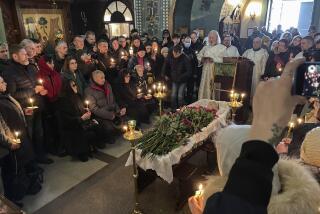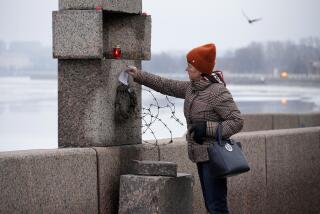Debate Over Lenin’s Place of Rest Lives On
MOSCOW — Nikita Muchnik, a student who sells cellphones at a department store near the Kremlin, doesn’t much care whether the embalmed body of Vladimir I. Lenin stays in its airtight glass coffin in Red Square or is banished from its place of honor. In his mind, the Soviet founder has already sunk to the level of a cynically exploited tourist attraction, a kind of real-life Madame Tussaud wax figure.
“I don’t think it’s a particularly good thing that he’s lying where he is, and I don’t find it particularly pleasant to walk past there,” Muchnik, 18, said. “But those people who were affected by communism feel strongly about it.... He’s good for tourists. It’s good for making money, but it strikes me as a bit immoral.”
Yet Lenin, who died more than eight decades ago, is still a potent symbol for older Russians. Some associate him with equality, social benefits and job security. To others, he symbolizes repression, terror and dictatorship. After all, Lenin’s tomb, upon which generations of Communist leaders stood to review military parades, was an icon of the Soviet era.
Now a fresh wave of pressure is building for Russia to make a decisive psychological break with its past by burying the revolutionary who so dramatically influenced the 20th century. But authorities know it won’t be that easy to put Lenin six feet under. Even former President Boris N. Yeltsin, at the height of his post-Soviet powers, succeeded only in banishing the goose-stepping guards in front of the dark red stone mausoleum.
Ruling party lawmaker Andrei Isayev, along with many others who want the body and mausoleum gone from the square, says the continued honor paid to Lenin is undercutting Russia’s efforts to modernize and democratize.
“I belong to the group that believes the damage done by Lenin to our country and our society is immeasurably greater than any good he may have done,” Isayev said. “He is completely out of sync with the reality of today’s Russia.”
Isayev predicted that in time, Lenin would be removed from the square. “The right moment has to be chosen,” he added. “This has to be done at a time when society embraces this with maximum calm.”
Polls show that Russians are gradually moving toward the idea that Lenin should be buried. A survey late last year by the All-Russian Public Opinion Research Center found that 52% of respondents favored burial, up from 43% in 1999, whereas 22% said Lenin should stay in the mausoleum.
Vladimir Panko, a security guard, counts himself among that minority. He recently joined the line of visitors that winds past somber guards in a quasi-religious atmosphere, down flights of stairs to the underground tomb where Lenin rests in spotlighted splendor. The guards hush up anyone who speaks and hurry along those who linger more than a few seconds to gaze at the spectacle.
“In the past, schools used to teach us to think Lenin’s way. There were the ideals of socialism. Now there are no ideals like that. These days, people just think about earning money,” Panko, 41, said. “People sense the direction the authorities are going in, but I don’t think they’ll manage to bury him in the near future.
“People are against it, especially in the provinces. It’s our history. I believe he should be left there.”
Displayed formally in a suit and tie, the body is so perfect and yet unreal that some visitors suspect it really is a wax figure, but those involved in its upkeep say there is nothing artificial about it.
The body has been preserved using a secret chemical solution and sophisticated equipment to control temperature and humidity inside the sealed coffin, said Yuri Denisov-Nikolsky, deputy director of the VILAR Scientific Research Center, the organization in charge of the body.
Contrary to visitors’ impressions, cosmetics are not used, Denisov-Nikolsky said. “Using fiber-optics, several dozen beams of light are projected onto Lenin’s body,” he explained. “These lights have filters that create the illusion of a particular color of the skin. So it’s with the help of these technological methods that we are able to achieve a skin color that more or less resembles that of a human being.”
Those battling on both sides of the burial debate accept the body as real.
Latest to jump into the fray is the Institute of Russian History, part of the prestigious Russian Academy of Sciences, which issued a statement this month condemning Lenin and his successor, Josef Stalin, saying they bore the “main personal responsibility” for decades of communist repression and terror.
Russia can progress on the path of democratic development, the statement said, only by rejecting communist icons Karl Marx, Friedrich Engels, Lenin and Stalin, whom it described as symbols of “Red Terror and the export of socialist revolutions.” The history institute called for the mausoleum to be torn down and for Lenin’s body to be given to the Communist Party to do with it as it pleased.
“If a mausoleum with Hitler’s remains existed in Berlin, wouldn’t that intimidate other countries and peoples? Or would it be considered acceptable?” said Vladimir Lavrov, the acting director of the institute.
Politicians hoping to burnish Russia’s democratic credentials have tried to get Lenin’s body out of the square since 1989, when Yuri Karyakin, a former dissident elected to a new Soviet parliament, shocked his colleagues by proposing such action.
Reformist Leningrad Mayor Anatoly Sobchak declared in September 1991 that within a month Lenin would be buried in that city, now known again as St. Petersburg, its czarist-era name. “I have a premonition that the hex will not be lifted from our country as long as this corpse stays on display in our main square,” he said.
But Lenin stayed put.
During his 8 1/2 years as president, Yeltsin repeatedly called for Lenin to be buried. But, concerned about widespread opposition, he never used his power to simply do it.
At a news conference in 2001, President Vladimir V. Putin expressed caution on the issue, saying it would be a mistake to move Lenin immediately but implying he might eventually back the idea.
“About the burial of Lenin -- I am against it, and I will tell you why,” Putin said. “Our country lived under the monopoly power of the Communist Party for 70 years. This is the lifetime of a whole generation. Many people associate their own lives with the name of Lenin. To them, the burial of Lenin would mean that they had worshiped false values, that they had set false tasks for themselves, and that they had lived their lives in vain. We have many such people.”
But in his next breath, Putin predicted that as time passed, public attitudes toward Lenin would change. “If we change the economy and the political sphere, this will inevitably lead to changes in the mentality of the overwhelming majority of the population,” he said. “And then, relying on a new world outlook of, I repeat, the overwhelming majority of the population, we will do the will of the people of Russia.”
For Putin, Lenin’s symbolism cuts two ways. Russia has a particularly harsh form of what is sometimes called “Wild East” capitalism, with a system that favors the rich and offers few comforts to the poor. Lenin the anti-capitalist is not welcome among the country’s new elite.
But Putin is a former KGB agent, and within his administration he has promoted many security service veterans, so he cannot turn too roughly against the man who founded the Soviet system.
The current wave of efforts to get Lenin out of the square began in September, when Georgy Poltavchenko, a senior aide to Putin, called for the body to be buried and for the remains of all those interred along the Kremlin wall to be moved.
“Many people have wreaked havoc in our country, but only a few of them were held accountable for these troubles when they were alive,” he said. “It seems to me that it is not very fair that those who initiated these troubles are located by the Kremlin, at the very center of the state.”
Although Poltavchenko said he was expressing a personal opinion, his comments were widely taken as a trial balloon intended to reignite discussion of the issue as a prelude to possible action.
The Communist Party sees the talk about burying Lenin and taking down his statues as an attack on itself and the generation that fought World War II and then built the Soviet Union into a superpower.
“Those who keep raising this issue pursue several goals,” Communist Party head Gennady A. Zyuganov said.
“Some want to tar Soviet history once again. Some want to pit one part of society against another and cause the country to explode, while others want to take advantage of confusion and get closer to positions of power.... Lenin is an inalienable part of our history, and a glorious part of it. He belongs where he is in Red Square, and in his current condition, whatever his and our enemies choose to say,” Zyuganov said.
Archpriest Vsevolod Chaplin, a spokesman for the Russian Orthodox Church, which has repeatedly called for Lenin’s burial, said making a show of his body was “not normal” from the viewpoint of church traditions.
“The body of the deceased is displayed to the public at large as a kind of tourist attraction,” he said. “I think that Lenin’s followers themselves should consider such a position as insulting.”
Chaplin counseled, however, against taking abrupt steps. “It is not the kind of issue for the sake of which to split society,” he said.
Stanislav Belkovsky, a prominent political scientist, told the newspaper Kommersant that he was convinced Lenin would soon be gone from Red Square.
“Vladimir Putin has been preoccupied with the idea of taking Lenin’s body out of the mausoleum,” Belkovsky asserted. He even predicted when it would happen: on Nov. 7, 2007, the 90th anniversary of the Bolshevik Revolution and just months before Putin is to step down, as mandated by the constitution.
“It will be the final chord of Putin’s term in the Kremlin,” he said, “because he will have nothing to lose.”
More to Read
Sign up for Essential California
The most important California stories and recommendations in your inbox every morning.
You may occasionally receive promotional content from the Los Angeles Times.










